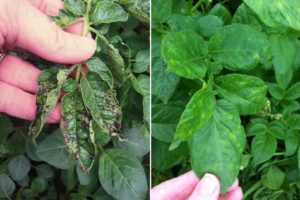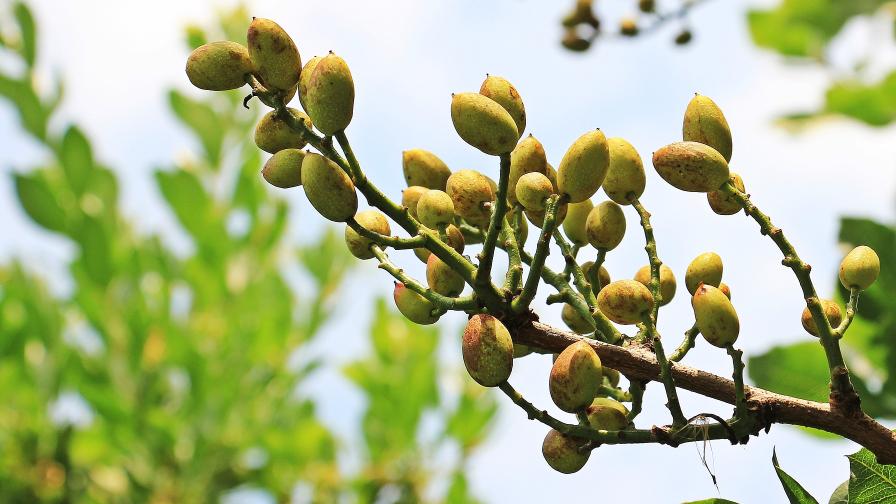Why Potato Virus Y Needs Your Attention

This is what Potato virus Y looks like on two different varieties: Canela Russet (left) and a chipping potato (right).
Potato virus Y (PVY) is one of the most common problems in potato fields, but few people know it when they see it. With plenty of other things to worry about, some growers may not consider PVY a serious threat and have not learned to recognize the symptoms. But this attitude is changing as more potato crops are impacted by the virus.
PVY has been around a long time but only recently has become a seriousproblem for potato growers in North America. There are some reasons for this.
Why Is PVY Is a Bigger Problem Now?
Hidden infections go undetected too long. Visual detection of infected plants is more difficult since the adoption of new cultivars that show no symptoms or only mild symptoms when infected with PVY. ‘Russet Norkotah’ is the most notorious of these mildly symptomatic cultivars, but there are many others. Moreover, new PVY strains that only cause minor symptoms in potato foliage have become more prevalent.
Both of these circumstances have allowed the amount of PVY circulating in potato-growing regions to increase. It’s a “Typhoid Mary” effect where asymptomatic plants become an important reservoir for the virus.
Seed potatoes are now screened for PVY. Many of the seed certification agencies, which traditionally rated seed lots for virus based on visual inspections, have added PVY testing. The impact on potato seed growers has been significant, since infected seed lots are downgraded or rejected if they have PVY levels that exceed established tolerances. Seed growers are now challenged to manage a problem tht can’t always be seen.
PVY is causing secondary, more serious problems. Another reason for increased concern is that some of the new strains can cause potato tuber necrotic ringspot disease (PTNRD). PTNRD creates sunken or necrotic rings on the tuber surface that can extend into the flesh.
These strains are on the increase; we have already seen some loads of potatoes rejected due to PTNRD. This trend will continue unless we are more vigilant about managing PVY. An important first step is being able to recognize the symptoms.
How to Identify PVY
A characteristic symptom of PVY infections involves a yellow or light green mottling of leaf tissues — also known as mosaic.
Mild symptoms can be difficult to ID. Some mosaics are quite noticeable, but others only show up under cloudy conditions when the contrasting colors are easier to see. The mildest symptoms only give a lighter green hue to the plant. PVY-infected plant leaves may be crinkled. Entire plants may be stunted.
Some cultivars have a hypersensitive reaction to PVY that results in dark brown necrotic streaks on the leaves and stems and often progresses to leaf drop. Few growers associate these symptoms with the virus, though some commonly grown cultivars (‘Dark Red Norland,’ ‘Ranger Russet,’ and ‘Yukon Gold’) can have a hypersensitive response to certain PVY strains.
Symptom expression depends on the strain involved. The ordinary strain (PVYO) rarely causes tuber defects but usually gives the most severe foliar symptoms. The tobacco necrosis strain (PVYN) and the recombinant strain (PVYNWi) usually cause mild foliar symptoms.
The tuber necrosis strain (PVYNTN), as the name implies, is the most likely of the strains to cause PTNRD. All of the strains reduce yields.
How to Manage PVY
Clean seed. The best thing that you can do to minimize PVY in your crop is to start with clean seed. Buy limited generation seed known to have little to no detectable PVY. Get a copy of the health certificate and scrutinize the results from field inspections (percentage with mosaic ) and ELISA tests (percentage with PVY).
A couple of years ago, I was seeing a lot of PVY in ‘Alturas’ fields. It turns out that ‘Alturas’ seed was in short supply and many growers bought seed that had more virus than they usually accept. Most of these growers knew that yields could be reduced, but they did not understand the risk they were taking with tuber quality: ‘Alturas’ is susceptible to PTNRD when infected with PVYNTN. Some of these growers planned to limit further spread by applying insecticides to control aphids, but this tactic does not always achieve the desired results.
Be strategic in controlling aphids. The virus adheres to their mouthparts when they feed on infected plants and spreads when the aphids move to feed on nearby healthy plants.
Rapid transmission of PVY by aphids offers little opportunity to limit virus spread with insecticides. Some may help by controlling colonizing aphids, like green peach aphids, but they work too slowly to stop other aphids that spread PVY as they are passing through in search of plants they like more.
It’s better to apply products that interfere with virus transmission — like mineral oils or insecticides — that act as feeding deterrents. Mineral oils require frequent (sometimes weekly) applications using ground equipment when aphids are flying. This makes them a feasible choice for small acreages or some potato seed operations but not for larger operations.
Insecticides that are classified as selective feeding blockers, like Fulfill (pymetrozine, Syngenta) and Beleaf (flonicamid FMC Corp.) can be applied by air and offer some residual activity. Consult labels for appropriate rates and use patterns. AVG
Editor’s note: American Vegetable Grower® magazine welcomes its newest columnist, Carrie Wohleb. She was personally selected by longtime and now retired “Potato Pointers” columnist Phil Nolte. The American Vegetable Grower team is excited to have her share her expertise and insights with you.










